How to Play Janggi
Korean Chess
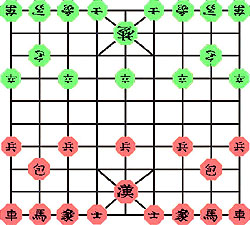
Janggi, the native chess of Korea, is derived from the same source as xiangqi, the chess of China. Janggi has much in common with xiangqi, yet it carries on some characteristics of an earlier version of Chinese chess; it also has some very interesting innovations. Arrangement The
pieces are arranged symmetrically, as shown above. They are
octagonal in shape, in varying sizes, placed on the intersections
of lines. Note that most of the pieces on the red side bear
different characters than their counterparts on the green side.
The red pieces are traditional Chinese characters, and most
of the green pieces show the same figures rendered in cursive.
A few of the pieces have different characters altogether, as
if to show that the two armies are truly different groups. The Pieces and Their Moves Here
are the red and green pieces, shown with their western names
(king, queen, bishop); their Korean names; the meanings of the
Korean names; and their various moves. |
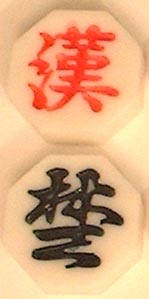 |
King,
“Koung,” General : Must stay within the nine-point fortress. He moves one point along any printed line in the fortress. Note that he moves diagonally only along the printed lines. |
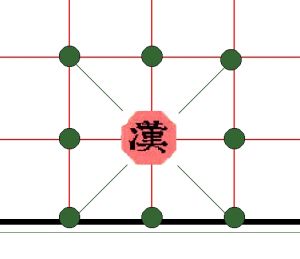 |
 |
Queen, “Sa,” Counselor : Moves exactly the same as the king, and is also confined to the fortress. | 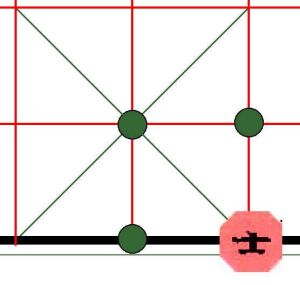 |
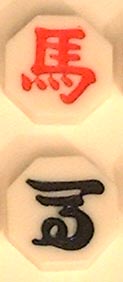 |
Knight, “Ma,” Horse : One point forward, backward, left or right plus one point outward diagonally, as shown in the diagram at right. This is similar to the western knight, but the Korean knight can be blocked. Note that in the diagram (right) the knight can not move to the red marked points, because he is blocked by the pawn on his right. (He is not blocked by the pawn on his left.) | 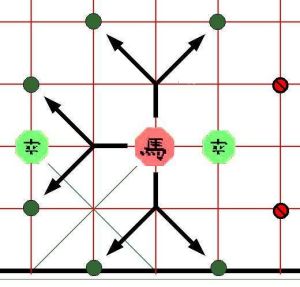 |
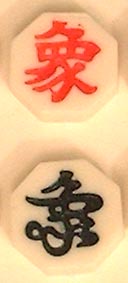 |
Bishop, “Syang,” Elephant : This piece has a very unusual move, found only in Korean chess. He starts one point forward, backward, left or right, and then moves two points outward diagonally, like an extended knight’s move. He can be blocked anywhere along this path, as he is in the diagram by the green cannon, and by the red rook. | 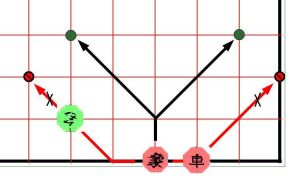 |
 |
Rook, “Tcha,” Chariot : Moves as many points as he wishes, in a straight line, along the lines of the board. This is the same move as the western rook, but note that the Korean rook can also move along the diagonal lines in the fortress, if he is already on one of these points. He can not jump over pieces (such as the red queen in the diagram), and he captures as he moves (and so, can capture the green piece at his right). | 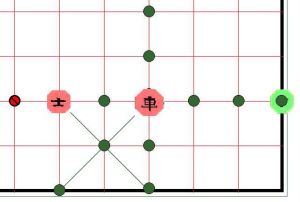 |
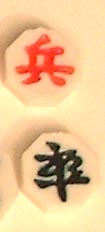 |
Pawn, “Pyeng (red) / Tjol (green),” Foot Soldier: One point, either forward or sideways. | 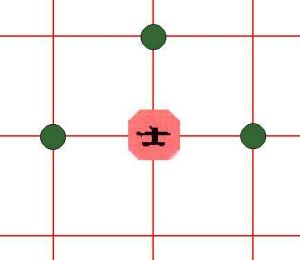 |
| Within the fortress, the pawn may also move forward along the printed diagonal lines. The diagram shows the green pawn, with his increased power of move, approaching the enemy general. |  |
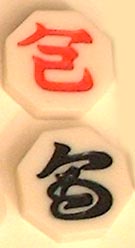 |
Cannon, “Hpo,” Cannon (a leaping rook) : If you are acquainted with Chinese chess, note that the Korean cannon has some important differences. The cannon moves along any straight line, including the lines within the fortress, but must have one piece to jump over. In the diagram below, the cannon (H) can move to point A (jumping over the pawn at B); to M (jumping over K); to E (jumping over F); and may capture the green piece on D. He may not jump over more than one piece (to point C), and may not move without jumping (points G, L and N). Also, he may not leap over another cannon (friend or foe) (can not go over I to J), and may never capture another cannon. |
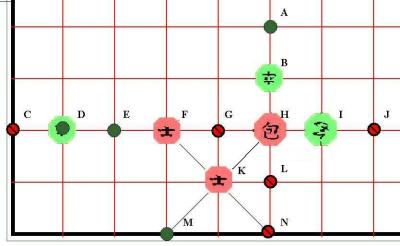
Before play begins, the players have the option of changing the positions of the bishops and knights. The first player (usually Red), if he chooses, may place the bishop in the knight’s place, and the knight in the bishop’s place, on his left side, on his right side, or on both sides. The second player (usually Green) then has the same choices of bishop and knight placement. Each player must maintain one bishop and one knight on each side of his line-up; he can not begin with two knights or two bishops together on his left or right. After the bishops and knights are arranged, the last player to arrange his bishop and knight (usually Green) makes the first move. The two sides alternate, moving one piece in each turn, in an attempt to force the capture of the enemy king (general), just as in other forms of chess. When a king is left with no option but to be captured in the next move, he is in checkmate, and has lost the game. All pieces capture by using their normal moves and landing on a point occupied by an enemy piece. The enemy piece is removed from play for the rest of the game. Note that, as a rule, pieces which move straight along the horizontal and vertical lines of the board also may move straight along the diagonal lines drawn within the fortress. The kings may not face each other, with no intervening pieces between them — except in the following case. If one player finds himself with less powerful pieces on the board than his opponent, he may take the option of facing the other king, with no pieces intervening between the two, placing the opponent in check. The opposing king must then move out of check, and the game continues. The player who uses this option, however, forsakes all possibility of winning the game. Even if, later, he checkmates the enemy king, the game is considered a draw. This special check by the king may happen more than once, by the same player. A player may use his king to essentially defend an attacking piece in the enemy fortress, since the opponent can not capture the piece with his king and face the opposing king (except in the above situation). If a player uses his king in this way, to defend a piece which is in the enemy fortress giving checkmate, the game is considered to be a draw, not a win. If a player finds himself in a position in which he has no safe or desirable move, he may pass. To indicate this, he simply flips his king over in place, and it is the other player’s turn once again. If a player forces continual repetition of the same positions, and does not wish to break the pattern, the game is declared a draw. Finally, if both players agree that there is no remaining possibility of either player winning the game, it is declared a draw. |
Download a free rule booklet ------ Shop for a playing set
HOME
PAGE CHESS PRODUCTS: International | Asian | Reproductions | Unique | Rare | Other Games CHESS HISTORY PAGES: 1 | 2 | 3 | 4 | 5 | 6 | 7 | 8 | 9 | 10 HOW TO PLAY: Chess | Courier Chess | Sittuyin | Xiangqi | Shogi | Shatranj | Janggi Makruk | Shatar | Dou Shou Qi | Luzhanqi LINKS: Chess Variants | Chess History | Chess Articles | Mah Jongg AFFILIATED SITES: Rick Knowlton | Courier Chess | Knowlton Mosaics Ken Knowlton | Insite Age | VerySpecial.us CONTACT US |